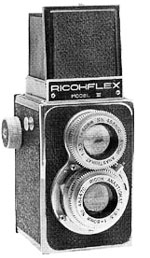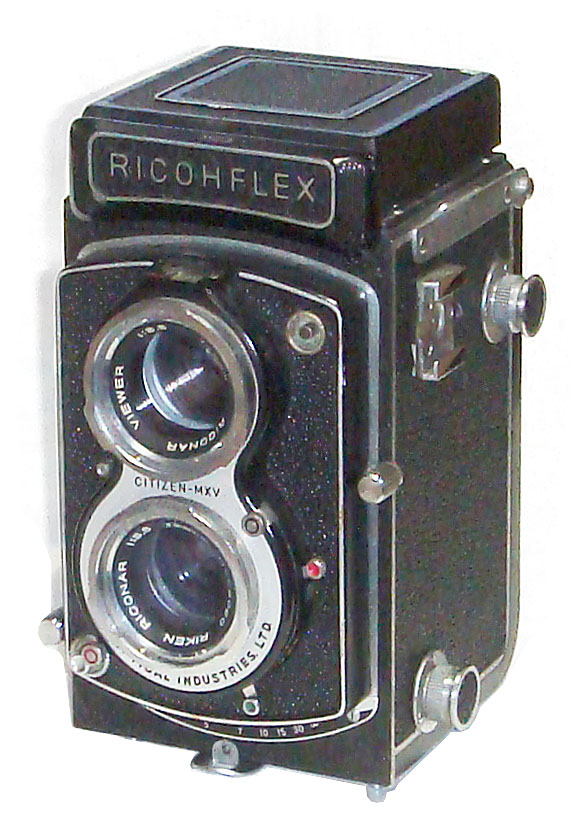 Though Ricoh Co.,Ltd. had been making a twin-lens reflex from before the War. A simple RICOH FLEX type III, soon after the War, was sold in 1950. There were still a few cameras in the market, and it seems that this attractive price was very sensational against to the Rolleiflex and so on, which was 5,800 yen and a case 1,500 yen option. When it was reflected well, the simple structure that the view lens was combined with the taking lens with the gear was excellent on the cost, and this reputed camera was easy to use, too. A Voigtrander BRILANT TLR has already employed the gear combination form before the War. The Ricoh Flex type III is known that the camera which made the TLR boom after the War in Japan.
Though Ricoh Co.,Ltd. had been making a twin-lens reflex from before the War. A simple RICOH FLEX type III, soon after the War, was sold in 1950. There were still a few cameras in the market, and it seems that this attractive price was very sensational against to the Rolleiflex and so on, which was 5,800 yen and a case 1,500 yen option. When it was reflected well, the simple structure that the view lens was combined with the taking lens with the gear was excellent on the cost, and this reputed camera was easy to use, too. A Voigtrander BRILANT TLR has already employed the gear combination form before the War. The Ricoh Flex type III is known that the camera which made the TLR boom after the War in Japan.
 Improvement was piled up after that, and a ricoh Flex New Dia model(photograph) appeared in 1956. The lens cover of the unity type was stuck around the both lenses, and the value of the shutter and aperture could be seen from the top like Rolleiflex. Though the looks often likes Rolleiflex 35C, the difference is understood as for the camera if it is seen well to do focusing with the lever on both side of the body. When a twin-lens reflex approaches it for the completion, it is an inevitable thing to look like Rolleiflex by all means.
Improvement was piled up after that, and a ricoh Flex New Dia model(photograph) appeared in 1956. The lens cover of the unity type was stuck around the both lenses, and the value of the shutter and aperture could be seen from the top like Rolleiflex. Though the looks often likes Rolleiflex 35C, the difference is understood as for the camera if it is seen well to do focusing with the lever on both side of the body. When a twin-lens reflex approaches it for the completion, it is an inevitable thing to look like Rolleiflex by all means.
The view lens is RICONAR VIEWER 80mmF3.5 and the main lens is RICONAR 80mm F3.5(tripret). The shutter is Citizen MXV, B, 1 -1/400 sec. with MX contact point. There was RIKENON 80mm F3.5(Tessar) with Seikosha MX as a variation, too. Though film loading evolves for the start mark-type, it doesn't reach the perfect auto-mat of Rolleiflex. Weight is 1,050g. A price in those days was 12,800-16,000 yen in Japan.
|